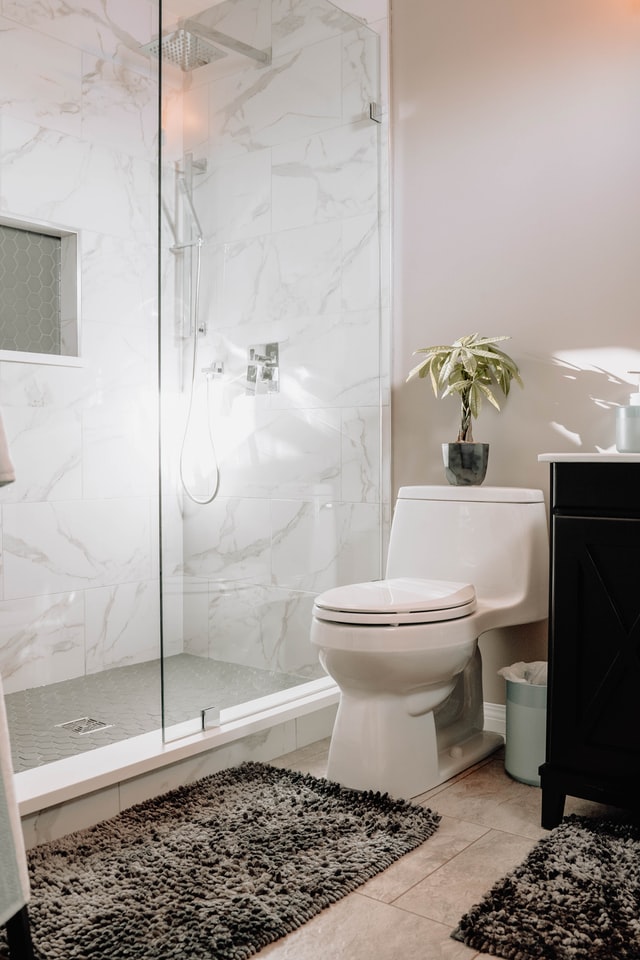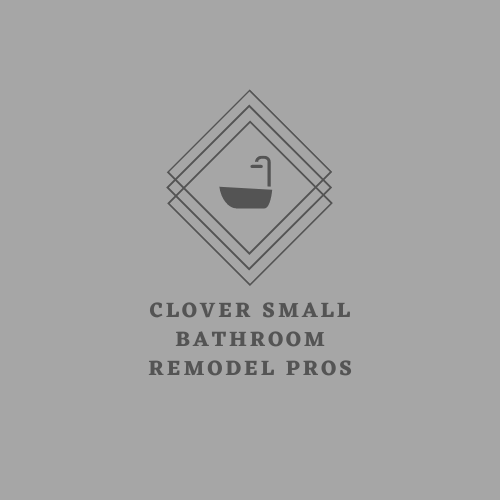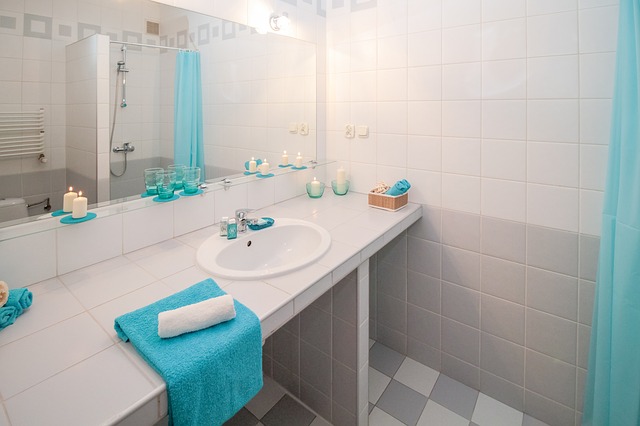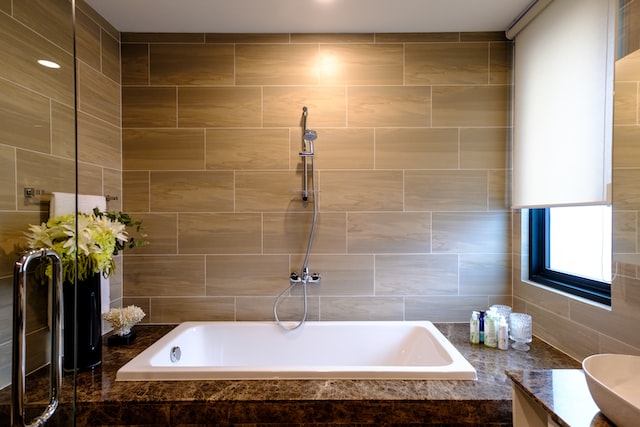This is an excerpt from the Book called “The Bathroom Idea Book” by Andrew Wormer. Continue reading to learn more about Natural finish material, thanks to the author.
Ceramic Tile
Composed of clay, ground shale or gypsum and other ingredients from the earth, has a 6000-year history. It’s not likely to go out of style any time soon. Stones such as marble, granite, and slate can also be cut into ceramic-like tiles, though they are also available as larger slabs. Uniformly cut (called gauged) stone is usually polished, while cleft stone has an irregular (and therefore, harder to keep clean) surface.
Wood has a warm, rich color and texture that can offset some of the colder and harder materials, like metal and glass, that are often used in the bathroom. Decay-resistant woods, such as cedar, redwood, and teak, are more suitable for wet areas, but most species can be used in noncritical areas—for cabinets or wall finishes, for example—if properly protected with the right finish.
Choosing Tile
Ceramic tile’s variety, versatility, and durability make it a popular bathroom finish material. But how do you decide whether to choose a generic 4-in. by 4-in. white tile that costs $1.00/sq. ft. or an almost identical-looking designer tile that needs to be special-ordered at $7.00/sq. ft.? Which tiles are best for floors? Do you need a special tile for the shower?
Permeability, or the ability to absorb moisture, is one way of comparing tile. Vitreous tile has a dense body and absorbs a negligible amount of moisture. It’s better suited for wet or exterior installations than nonvitreous tile, which is softer and more porous. Because nonvitreous tile is fired for a shorter period of time at a lower temperature, it’s less expensive to manufacture (and therefore to buy) than vitreous tile. In practice, both vitreous and nonvitreous tiles are used interchangeably in the bathroom, since the tile’s glaze protects it against most moisture.

Another way of comparing tile is by the relative hardness of its surface. Tile manufactures use the Mohs scale, which ranges from 1 (the softest), to 10 (the hardest), to grade their tile. Floor tile needs to be more resistant to scratching than wall tile and should rate at least 6 or 7 on the Mohs scale.
Texture should be another concern when choosing tile. Although the shiny smooth surface of a polished or smoothly glazed material may look great and be easy to clean, it can be slippery when wet. It’s better to choose a tile that has a textured or matte glaze for floors and save the shiny tiles for the walls and countertops.
When you go to choose tile, you’ll notice that some of it is graded and some of it isn’t. Standard-grade tile accounts for about 75% of all tile sold and meets standards set by ANSI (American National Standards Institute). Second-grade tile is cheaper than standard grade and may have slight inconsistencies in either its size or glaze, though it is functionally the equivalent of standard-grade tile. Ungraded tile of varying quality is also available. Some of it is perfectly okay to use (Mexican pavers can fall into this category), while some is of decidedly inferior quality. Decorative tile should be used for just that purpose: it’s too fragile for functional use.
The best way to choose tile is to know what the tile will be used for, pick out something you like at a tile store, take some samples home, and put them through a few scratching. Rubbing, and scuffing tests.
Wood Finishes
Wood has a natural warmth and texture that make it an appealing bathroom finish. Consisting primarily of fine cellular ducts that once carried water and dissolved minerals from the roots upward, wood that has long been cut and milled into lumber still has the capability of absorbing and releasing moisture. This can be bad news, because wood that is exposed to water will begin to decay. Some woods — teak, cedars, and redwood, for instance—are more decay-resistant than others, making them more suitable for the damp environment of a bathroom. But given proper preparation and protection, most wood species have their place in the bath.
Wood flooring offers a warm contrast to some of the other harder and sometimes cold-feeling materials often found in the bathroom. Most common flooring species—oak, maple, cherry, even pine—can be used successfully, given proper preparation and installation. Wide boards shrink and swell more noticeably than narrower ones, so 2 1/4 –in. strip flooring in one of the relatively stable species is less likely than wider plank flooring to be affected by the humidity swings that are common in the bathroom. Choose a coating-type finish, such as polyurethane, that isn’t easily affected by standing water and that can be mopped rather than a penetrating-oil finish that is less resistant to water.
Wood can also be used for countertops. It’s easily cut, installed, sanded, and repaired, and it’s easy on grooming aids and glass-ware that get dropped onto it. Maple butcher block is a popular ready-made countertop material that is sold by the running foot in varying widths. Other popular countertop woods include teak and redwood. Cutouts for sinks can present a problem unless the cut edge is properly sealed against moisture. Again, a polyurethane-type coating sealant is the best choice for a finish.

Wood is also a good choice as a wall and ceiling covering, though its use in shower areas where it’s constantly exposed to moisture is ill-advised. Besides its natural beauty, wood can help soundproof a room and make it feel warmer. Tongue-and-groove wainscoting topped with a chair rail, either painted or clear-coated with polyurethane, offers a traditional treatment that is durable and easily cleaned.
Panelling on walls and/or ceilings is another option. Vertical v-groove panelling has a rustic look and can be installed diagonally or horizontally. Square-edged panelling has a more subtle and contemporary look because of the absence of prominent shadow lines. Bevel-edge siding in cedar or redwood, more commonly used on exterior walls, can also be used to good effect as a wall treatment.
Synthetic Materials are typically marketed as more widely available or less-expensive substitutes for natural materials. Plastic laminate, for example, is still by far the most popular countertop material in the world. Solid-surface materials were introduced only a couple of decades ago but have become increasingly popular with designers and homeowners. These materials have many of the properties of stone but are more easily fabricated. While far more expensive than plastic laminate and available in only a limited number of colors, solid-surface materials are easily repaired. Like laminate, they can be used in any area of the bathroom.
About Solid-Surface Materials
DuPont began the solid-surface revolution some 30-odd years ago when it developed a technique for blending natural minerals with acrylic resin. In addition to DuPont’s popular Corian, there are now several other solid-surface materials to choose from, including Formica’s Surell and Wilsonart’s Gibraltar. While each has different composition, color, and texture, all solid-surface materials share certain qualities and characteristics that make them ideal for a bathroom environment.
Unlike plastic laminates, solid-surface materials can be repaired if they get burned or scratched (simply by sanding and buffing out the defect). They are repairable because the material is nonporous and the color goes all the material is nonporous and the color goes all the way through-making them difficult to stain in the first place. They’re unaffected by most chemicals, with the exception of some paint removers and oven cleaners, and are even fairly resistant to heat damage. You probably won’t chop onions or set a hot frying pan down on a bathroom countertop, but if you manage to damage it—and it’s made of solid-surface material—it can be fixed.
Solid-surface materials are available in ¼-in., i/2-in., and ¾-in. thicknesses of varying lengths and widths. They can be used in a number of bathroom applications besides countertops. For example, their smooth, easily cleaned surface makes them ideal for tub and shower surrounds. Some manufacturers offer thinner 1/8-in. solid-surface veneers as a more economical alternative to the full thickness materials.
Premolded solid-surface sinks are available in a limited number of sizes, shapes, and colors to coordinate with most manufacturers’ product lines. Specialty shops can fabricate custom countertops with seamlessly welded integral sinks that match (or contrast with) your chosen countertop material.
A major advantage of solid-surface materials is that they can be readily tooled with standard woodworking machinery. This isn’t a job for the faint of heart, though: this stuff is relatively expensive. In addition, some manufacturers won’t sell the material to anyone who hasn’t completed a fabricator’s certification course.
But the ability to cut, shape, turn, rout, sand, and polish solid surface is what makes it unique. Some solid-surface materials can even be molded into custom shapes. And at least one (Corian) is available in liquid form and can be poured into inlay patterns. More and more different ways to use solid-surface materials are being developed every day.
Choosing between the different kinds of solid-surface materials available will require some home-work. Don’t rely on product literature; get sample kits containing actual small blocks of the material to help you compare the colors and textures that each manufacturer has to offer.
All About Laminates
When Daniel O’Conor invented plastic laminate as an artificial substitute for the mineral mica back in 1913, his employer, Westinghouse, took little notice. So he and a friend formed a new company to produce the new material and began to think of new applications for it. They called their new product and their new company Formica. In 1927 the first sheets of high-pressure decorative plastic laminate (or HPDL, the technical term for the product) began to appear. It became a popular building material in the post-war building boom of the 1940s and 1950s. Now, it’s by far the most popular countertop material around the world.
Plastic laminate is made of several layers of Kraft paper, a layer of decorative paper (which provides the color and pattern), and a top protective layer of melamine. This sandwich is saturated with phenolic resin, put under high pressure, and cooked until all the ingredients bond together into a single sheet of plastic.

In addition to the familiar varieties of laminate, there are some interesting recent variations. One of these is solid-core laminate, which doesn’t have the Kraft-paper core and corresponding dark line on its edge like regular laminates. Although unsuitable for countertops, these laminates can have almost mirror like finishes in metals like bronze, gold, copper, brass, and aluminium and are useful for unusual cabinetry designs. Wood-veneer laminates offer some exciting design options for cabinets and shelving. Laminates are even available as a flooring material.
Choosing laminate can be a bit overwhelming because there are so many choices in colors and textures. For countertops, at least, it pays to be a bit practical, since these surfaces can see considerable wear and tear. For example, matte finishes are preferable to glossy surfaces, which show scratches all too easily, or highly textured surfaces, which are more difficult to keep clean. Also, minor scratches in very dark colors appear to be white, because only the melamine top surface is affected. Darker colors also seem to highlight every speck of dust or errant glob of toothpaste.
One of plastic laminate’s big advantages is price. Expect to pay about $1.00 to $ 3.50 per sq. ft. for uninstalled sheet goods. Pre-cut countertops in a limited number of styles and colors are a great bargain at your local home improvement center, typically costing between $5 and $10 per running foot. Custom-ordered and installed countertops begin at about $50 per running foot. Laminate flooring begins at as little as $3 per sq. ft.
Paint And Painting Techniques For Bathrooms
Simply put, there’s no other finish that can transform an interior as dramatically and cost-effectively as paint. A wonderful source of color and texture, paint can be applied by almost anyone with a minimal investment in time, tools, and materials.
The first step is to choose a primer that is specifically intended for the harsh conditions of the bathroom. The best primers inhibit vapour transmission, and some of them (like some bathroom paints) are treated with a mildewcide and stain killer. Primers that are intended for wood trim are different from primers that are intended for drywall surfaces.
Paint is decorative, but it should also be durable and cleanable. Flat paints have a high pigment-to-resin ratio, so they’re good at hiding surface flaws and go on easily; unfortunately, they are almost impossible to keep clean. A better choice for often-scrubbed bathroom walls is gloss or semi-gloss paint, which has a higher resin-to-pigment ratio. Satin and eggshell-type paint formulations retain most of the cleanability of the high-gloss paints without the shiny look.
Alkyd (oil-based) enamels are generally more durable and abrasion-resistant than latex (water-based) enamels, but increasingly strict regulations regarding VOC (volatile organic compounds) content in paints and finishes have narrowed the performance gap. Latex enamels dry more quickly, clean up with water, and don’t have an overpowering odor while they’re drying. Paint that is intended for use on walls and ceilings should have a low-permeability rating, meaning that potentially damaging water vapour can’t easily pass through the paint membrane.

Choosing paint colors can be both exhilarating and intimidating. Color chips and charts from the various manufacturers help, as do general color theory design guide lines. But in practice, there’s nothing quite like seeing the actual paint in place in the bathroom. There, lighting conditions will show the paint in its true color and in relation to the other colors of the bathroom.
Besides experimenting with color, try some of the various decorative painting techniques. Stencilling is a relatively simple technique that was popular with colonial pioneers, particularly the Pennsylvania Dutch. Sponging, ragged finishing, and color-washing are other relatively simple techniques that an easily be mastered by amateur painters and which add subtle texture and color to ordinary wall surfaces.





